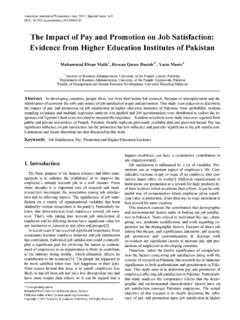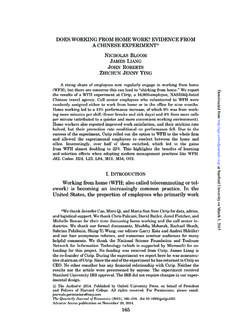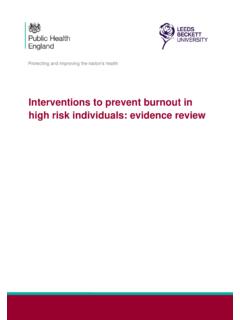Transcription of ORGANIZATIONAL - ASQ Human Development & Leaderhip …
1 1. ORGANIZATIONAL COMMITMENT. Unless commitment is made, there are only promises and hopes .. no plans.. Peter Drucker (1909-2005). Introduction It is commitment that gets the job done. This intense dedication is more powerful than our best intentions, willpower, or circumstances. Without commitment, influence is minimal;. barriers are unbreachable; and passion, impact, and opportunities may be lost (Maxwell, 1999). This primer explores the topic of ORGANIZATIONAL commitment, its possible influence on ORGANIZATIONAL efficiency, and actions leaders can take to build highly-committed workforces. ORGANIZATIONAL behavior is the study of beliefs, attitudes, and behaviors displayed by people in the workplace.
2 Behavioral scientists argue that managers who know why workers behave the ways they do are better equipped to motivate employees to contribute to the achievement of ORGANIZATIONAL goals. Gray &. Starke explain in their book, ORGANIZATIONAL Behavior, Concepts and Applications (1988, ) that the process for obtaining this knowledge involves understanding, prediction, and control. (See Figure 1) They write: Understanding is aimed at identifying and measuring (as accurately as possible) the major factors affecting a situation. If understanding is successful, patterns of behavior may emerge, and one can make certain predictions about behavior in light of acquired knowledge.
3 The ability to understand then predict makes it possible to control behavior. 1. Figure 1: The basic process of ORGANIZATIONAL behavior Prior to the Industrial Revolution, work was primarily accomplished in entrepreneurial environments and it is likely the commitment to work came from the autonomy and pride of individual ownership. The Industrial Revolution brought people together in factories and unions where they had to learn how to work with each other and become committed to organizations in which they had little control. The first ORGANIZATIONAL behavior research, such as the famous Hawthorne Studies, focused on improving worker productivity.
4 Later studies focused on examining the relationships between job satisfaction and job performance, and it was found that this relationship was not all that strong. Researchers then began to look at other attitudinal concepts, such as ORGANIZATIONAL commitment. Meyer and Allen (1997, ) reported: We started to conduct research on commitment in the early 1980s. Our interest was stimulated initially by practical considerations: What made some volunteers in nonprofit organizations so highly committed to their work and how might this sense of commitment be instilled in others? 2. Definition, Types, and Perspectives of ORGANIZATIONAL Commitment ORGANIZATIONAL commitment is the employees' state of being committed to assist in the achievement of the organization's goals, and involves the employees' levels of identification, involvement, and loyalty (Caught & Shadur, 2000).
5 It is an emotional response that can be measured through people's behaviors, beliefs, and attitudes and can range anywhere from very low to very high. John Meyer and Nancy Allen (1997) have identified three types of ORGANIZATIONAL commitment: affective, continuance, and normative. Affective or moral commitment occurs when individuals fully embrace the goals and values of the organization. They become emotionally involved with the organization and feel personally responsible for the organization's level of success. These individuals usually demonstrate high levels of performance, positive work attitudes, and a desire to remain with the organization.
6 Continuance or calculative commitment occurs when individuals base their relationship with the organization on what they are receiving in return for their efforts and what would be lost if they were to leave ( , pay, benefits, associations). These individuals put forth their best effort only when the rewards match their expectations. Normative commitment occurs when individuals remain with an organization based on expected standards of behavior or social norms. These individuals value obedience, cautiousness, and formality. Research suggests that they tend to display the same attitudes and behaviors as those who have affective commitment.
7 Zangaro (2001) suggests that an additional type, alienative commitment, may also exist. He writes that this occurs when individuals feel they have little or no control or impact, and would like to leave their jobs. These employees usually demonstrate low levels of performance. 3. In 1991, Meyer and Allen recommended that employee commitment be studied from both the attitudinal and behavioral perspectives. The attitudinal perspective focuses on identifying the events that contribute to the Development of commitment. The behavioral perspective focuses on identifying the conditions where behavior, once exhibited, tends to be repeated, along with its effects on changes in attitudes.
8 Figure 2 highlights the differences between these two perspectives. Figure 2: Attitudinal and behavioral perspectives on ORGANIZATIONAL commitment Assessments of ORGANIZATIONAL Commitment To obtain the data needed to effectively assess and manage employee commitment levels, employers may consider surveying their employees. The two most commonly-used assessment tools in ORGANIZATIONAL behavior research are Mowday, Steers, and Porter's (1979) ORGANIZATIONAL Commitment Questionnaire (OCQ), and 4. Allen and Myers' (1990) Three-Component ORGANIZATIONAL Commitment Scale. (See Appendices A and B). Employers interested in measuring their employees'.
9 Acceptance of the organization's goals, willingness to work hard for the organization, and desire to stay with the organization may find the OCQ useful. Employers interested in measuring their employees' levels of affective, continuance, and normative commitment could use the Three-Component ORGANIZATIONAL Commitment Scale. Prerequisites for ORGANIZATIONAL Commitment Regardless of what companies do, some employees display greater ORGANIZATIONAL commitment than others. Researchers have found that certain characteristics, attitudes, and relationships may play key roles in environments with high levels of ORGANIZATIONAL commitment.
10 (See Table 1). Personal characteristics are important factors in the Development of an individual's level of ORGANIZATIONAL commitment. Mathieu and Zajac (1990) have identified several personal characteristics: Age: Older workers tend to be more committed than younger ones. Some researchers have emphasized negative reasons for this finding: older workers have fewer occupational alternatives and would risk their benefits if they left an organization. Others have focused on findings that older workers have greater job satisfaction and have better jobs. Gender: Men tend to be somewhat less committed to organizations than women.








